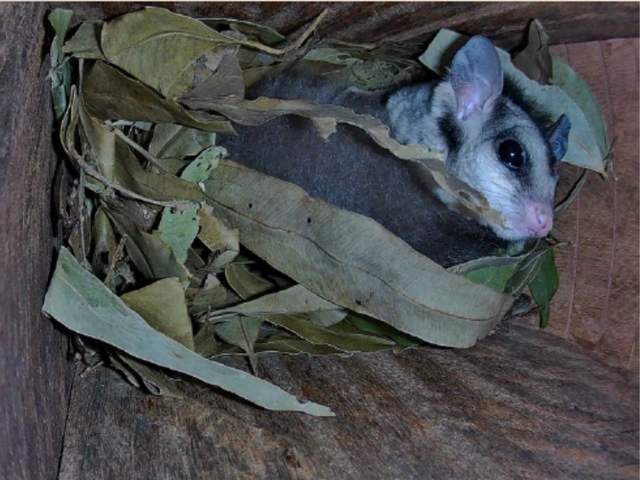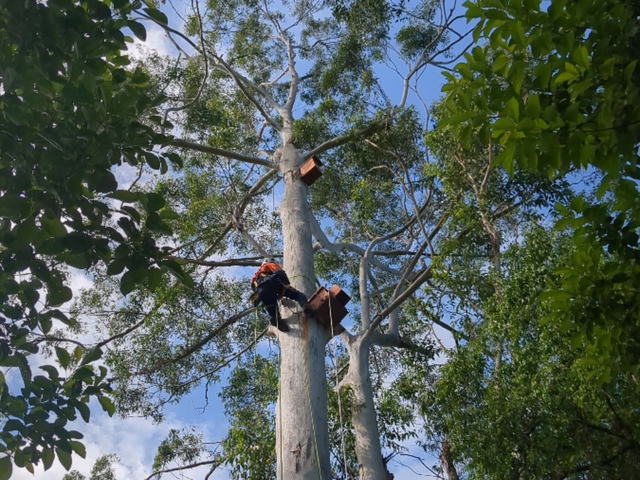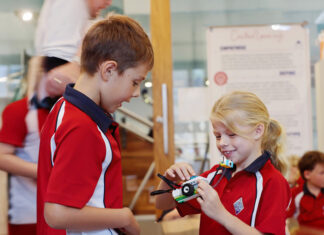After six months in the bush, 25 nestboxes installed in a Landsborough environment reserve are now a home for sugar gliders, brushtail and short eared possum, a peron’s tree frog and plenty more tree-loving wildlife.
Other nest boxes were unoccupied, but evidence of activity was found through chew marks and nesting materials.
Ten habitat stacks and more than 6900 trees were also planted across 4.33 hectares within the Mellum Creek Environment Reserve to offset the removal of trees and vegetation required for Unitywater to deliver new water network connections to the growing Aura community.
In late 2023, Sunshine Coast Council fulfilled the offset in the Mellum Creek Environment Reserve in Landsborough.
Council’s Natural Areas Offset Officer Steve Milner said the new nestboxes were expected to last for a minimum of 40 years.
“Council used native hardwood timber salvaged from other road development projects and milled it into 40mm rough sawn timber boards to construct the nest boxes,” Mr Milner said.
“The nest boxes were installed in the tree canopy in the Mellum Creek Environment Reserve to mimic hollows that would otherwise take hundreds of years to develop naturally.”
Mr Milner said very few trees here were that old due to past logging.
“Nest boxes are helping to bridge the gap, fast forwarding the process to create instant breeding habitat for our precious wildlife including the powerful owl, cockatoos, squirrel glider, greater glider, possum, micro bats and antechinus – a small mouse-like native marsupial,” Mr Milner said.
“This greatly benefits our region’s biodiversity and supports the survival of these species for generations to come.
“Apart from the obvious sustainability benefit of a longer lasting box, it also smells and feels more like the natural environment of our local fauna – and so we hope it’s more enticing as well.
“The 40mm thick native timber should also help the temperature and humidity inside the box remain constant and habitable.
“We are working with Unitywater to salvage any timbers that could be used for the course woody debris salvage program or Class A Durability timber for future nest boxes.”
Unitywater Executive Manager Strategic Engagement Joshua Zugajev said significant stakeholder engagement helped inform the pipeline route selection and construction methodology.
“As with all Unitywater projects, we sought to minimise the impacts of constructing this new essential infrastructure on the natural environment and local communities, with ecologists and arborists physically inspecting all vegetation to maximise what could be retained and sections of trenchless construction techniques to avoid environmentally and culturally sensitive areas,” Mr Zugajev said.
“Save Connect Protect shared extensive local knowledge with us including walking the alignment pre-clearance and in conjunction with our arborists, identified a number of Class A Durability timbers that will be used for future nesting box programs.”
“Where vegetation needed to be cleared, trees were inspected for native animals, and a wildlife spotter was on hand to safely remove and relocate them.”
Mr Zugajev said other trees that could be recycled would be reused through Council’s Course Woody Debris Salvage program to become habitat stacks in revegetation areas that are in need.
“Vegetation which does not meet the specification for either of these initiatives is being mulched and reused on the construction site for soil and erosion control,” Mr Zugajev said.
“We are also working with the local Queensland Parks and Wildlife (QPWS) Ranger to re-use some of the tree root balls as deterrents for illegal 4WD access into Ferny Forest.
“The newly cleared corridor also creates a fire break assisting with the QPWS bushfire management of the forest.”
Biodiverse Environmental designed, built, installed and monitors the nest boxes.








